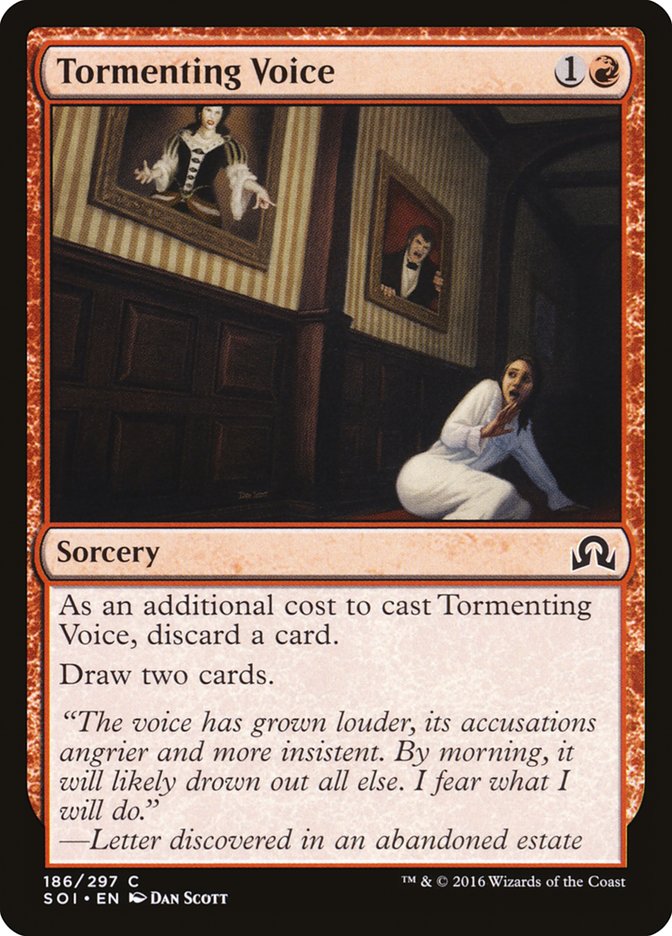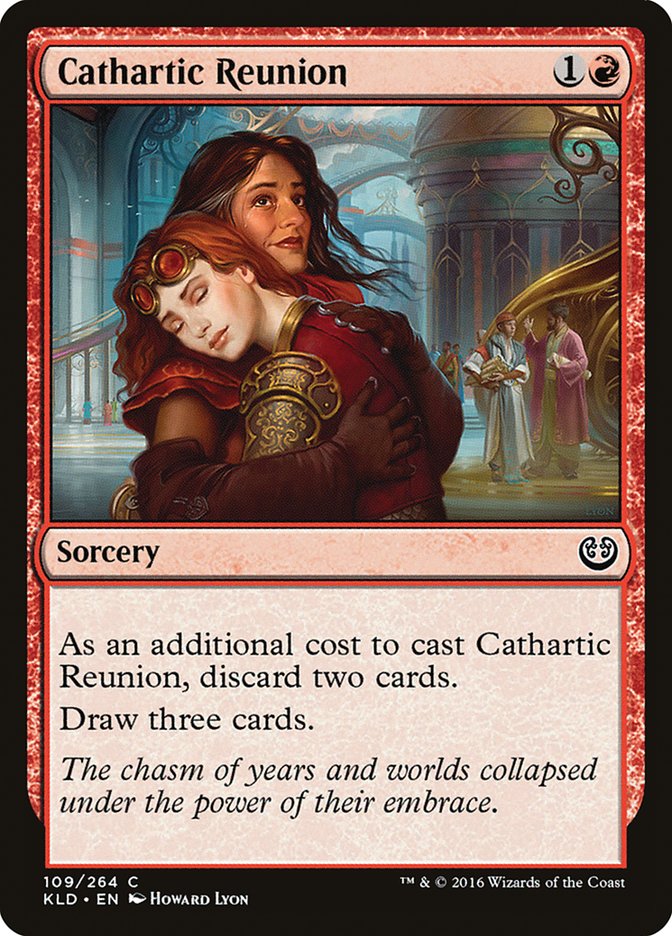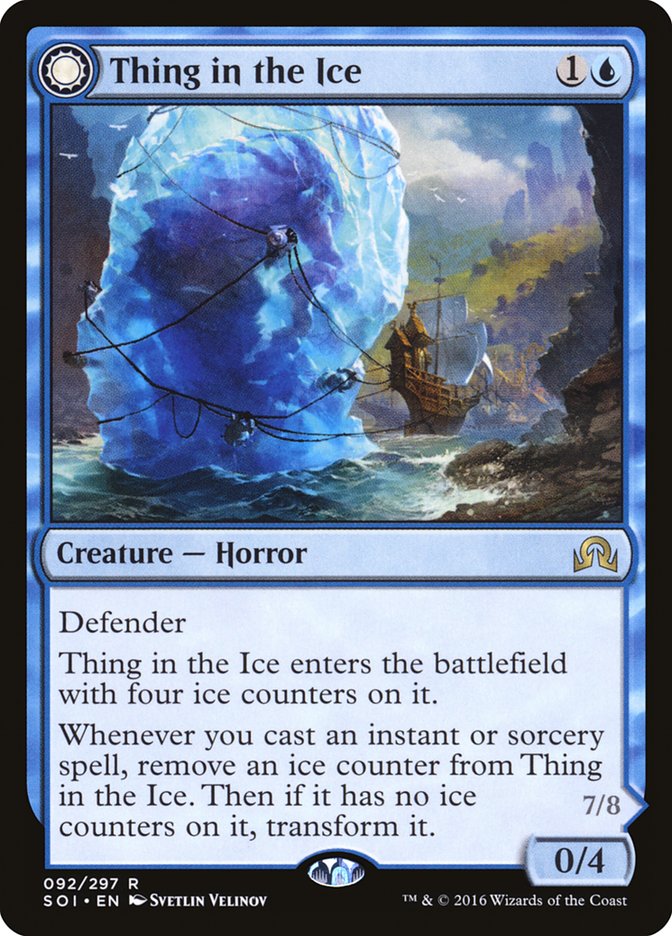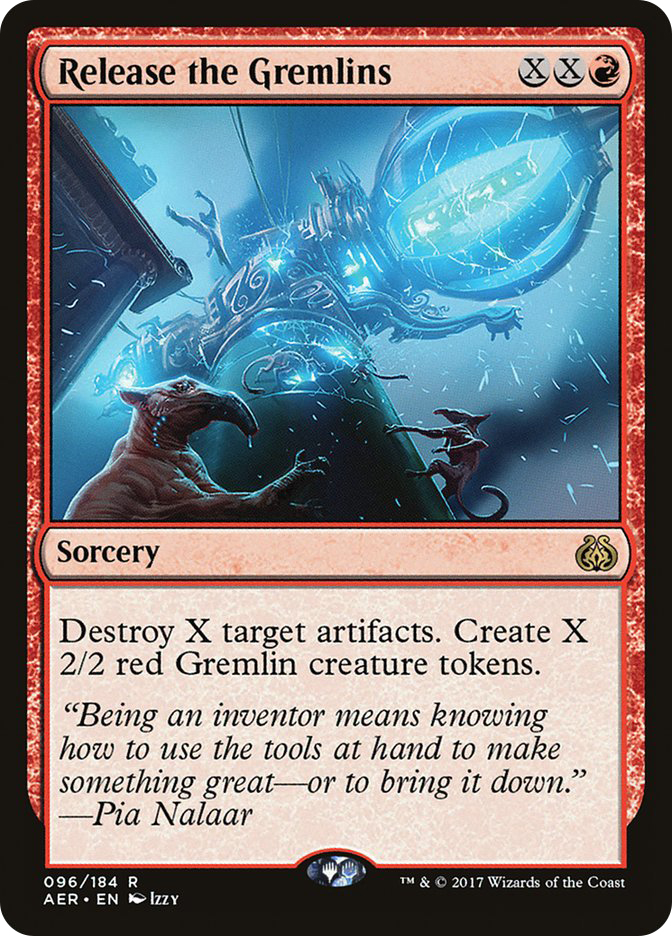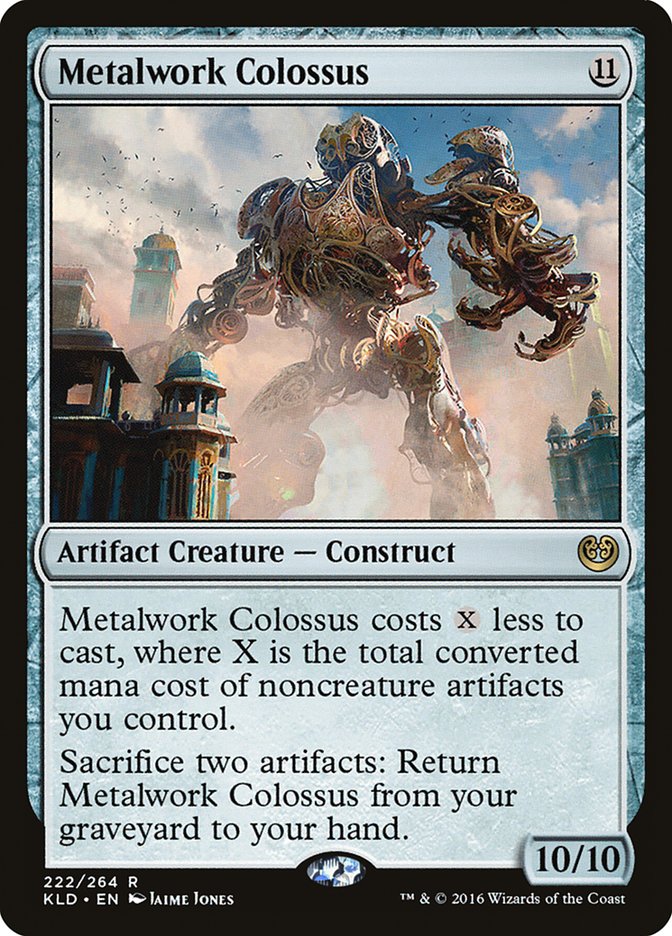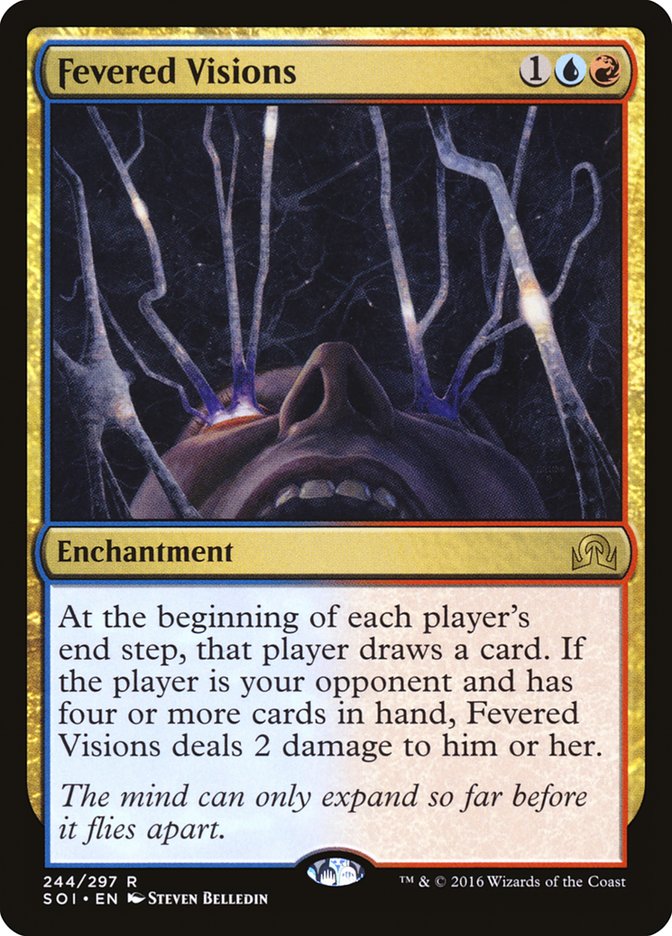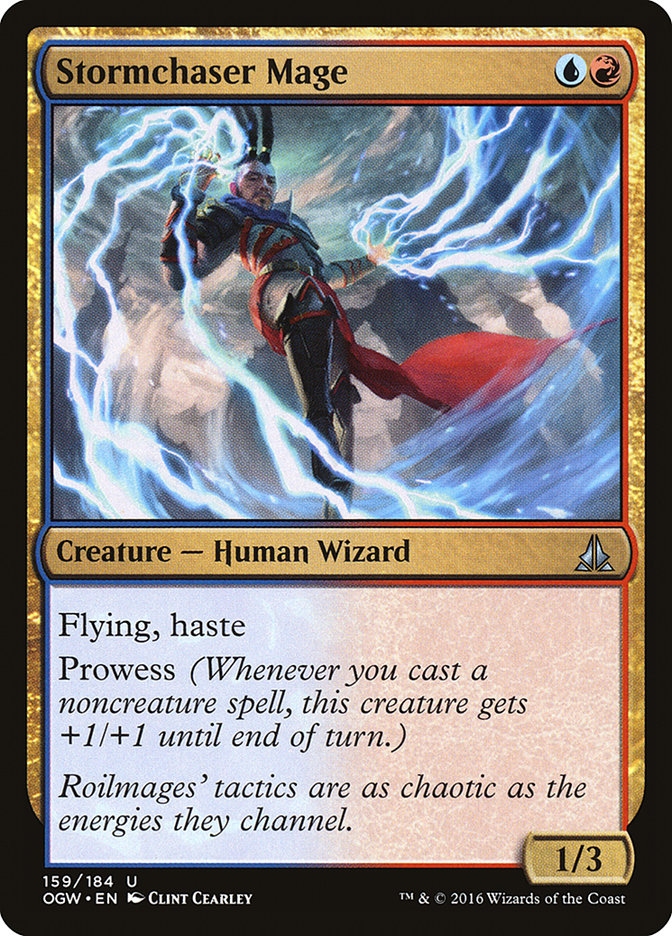There is quite a bit to talk about this week. So many people have already covered the bannings that I will only touch the topic as it relates to the decks I’m working on. Losing three cards in Standard is a big deal, and many of the rules have changed because of those three missing cards. I’m just glad people aren’t still going head over heels for Fatal Push anymore.
We get it. The name implies it is broken, and it is a very good card. Good enough for Standard? Maybe. Fatal Push certainly seems better than Dead Weight, aside from the purposes of hitting delirium. But we’re not talking about Fatal Push today. You’re not gonna believe this, but I think that blue and red are actually good again. Why? I might be crazy. They say the definition of insanity is doing the same thing over and over and expecting a different result.
But those people didn’t just see three major cards banned in Standard.
In some ways, the banning felt like Christmas morning. Three cards from the past year that all felt a bit too powerful, a bit too annoying, and a bit too much like Man-o’-War, now gone for good. Take that, people who said the problem was Aetherworks Marvel (me)! But seriously, these three cards leaving the format leaves a pretty big power vacuum up for grabs. My gut says that the void will be filled with Gideon, Ally of Zendikar, so building a deck that can attack it easily is probably the first place you’ll want to start.
But not me. Crazy, remember?
Creatures (10)
Lands (23)
Spells (27)
- 3 Shock
- 4 Fiery Temper
- 2 Negate
- 3 Tormenting Voice
- 4 Take Inventory
- 4 Harnessed Lightning
- 3 Dynavolt Tower
- 4 Cathartic Reunion
Sideboard

I’m very excited about the prospect of Baral, Chief of Compliance in these spell-based decks I’m always tinkering with. While Goblin Electromancer wasn’t exactly a staple when it was in Standard, I think Baral, Chief of Compliance is a significant upgrade. Not only is it easier to cast, but it also has a higher toughness, an added ability that isn’t all that relevant to my interest, and this Standard format has many more ways to abuse it.
For starters, being able to play both Tormenting Voice and Cathartic Reunion is pretty absurd. With access to these two spells, we get to cycle through our deck at a rapid pace, turning excess lands into removal spells, threats, or various answers. Playing Tormenting Voice and Cathartic Reunion can be dangerous, as counterspells will weaken their usefulness considerably. But with the banning of Reflector Mage, I’m hoping cards like Spell Queller see a lot less play. If that ends up not being the case, our sideboard full of Dispel, Negate, and Spell Shrivel can help us win counterspell battles with our opponent. Plus, those cards just so happen to give you loot potential with Baral, Chief of Compliance.
As I’ve already said, Thing in the Ice is in a unique spot with Reflector Mage out of the format. The tempo black hole that Reflector Mage put you in was a complete disaster. Yes, it only costs two mana, but the initial investment wasn’t the problem. Relying on Thing in the Ice to flip and actually win the game was important to the deck’s Plan A. If that fell to pieces, it was difficult to recover from just about anything the opponent threw at you on the following turn. Gideon, Ally of Zendikar was and is a nightmare, but being able to flip Thing in the Ice and bounce all their blockers was an easy way to overcome its strength. When Reflector Mage was waiting in the wings, this was a virtual impossibility.
Thing in the Ice might get a little bit worse with people gunning for the new Splinter Twin combo (Saheeli Rai plus Felidar Guardian), but that just means we get to rely on our secondary plan. Dynavolt Tower and Bedlam Reveler give the deck a good payoff for playing so many “cycling” cards. Instead of spinning your wheels frantically, you’re able to turn those cycling spells into something concrete. Draws that don’t feature one of your three big payoff cards often feel like you’re not doing much of anything. But luckily for us, we have a lot of ways to find those payoff cards.
I’m not sold on Shock over Galvanic Bombardment just yet, but the ability to hit opposing players with direct damage can keep the Saheeli/Guardian combo in check. Being able to help take out planeswalkers is a big deal, but you’d be surprised how much random damage can accumulate from Baral, Chief of Compliance and Wandering Fumarole attacking. A few hits from those can lead to a flurry of Shocks and Fiery Tempers to close out the game. Like most direct damage spells in the past, their biggest upside was being able to go to the dome in a pinch. While Shock isn’t a spell to write home about, we aren’t getting Lightning Bolt back anytime soon. We play with what we’ve got.
I’ve toyed with the idea of Incendiary Flow for similar reasons. If there is an increase in Scrapheap Scrounger, or the various Prized Amalgam decks, Incendiary Flow becomes a lot more appealing than your traditional removal spells. In similar U/R decks, I’m definitely looking at Incendiary Flow to make the cut. But with energy being a large factor in this strategy, Harnessed Lightning just barely gets the nod for me.
So far, I’ve also been very impressed by Release the Gremlins. Before Aether Revolt, there wasn’t a single red card that could destroy artifacts that was less than a four-mana investment. At the very worst, Release the Gremlins is a Manic Vandal. But when you let Baral, Chief of Compliance in on the mix, it starts to look a lot better. Plus, you can even cast it for one mana to get a trigger from Thing in the Ice or Dynavolt Tower. Not a bad deal, if you ask me. I’m honestly considering one or two for the maindeck since we have so many ways to discard it, and I fully expect to see a lot of artifacts in the future of Standard. There are just too many artifact-driven synergies.
I’ve seen this before.
Emrakul and the Gang
Emrakul leaving also means that some decks just don’t have to fear losing that late-game battle anymore. We don’t need Summary Dismissal. We don’t need to worry about playing too many burn spells that can turn against us. And we don’t need to worry about winning the game before our opponent is able to cast it. Midrange decks don’t have the same type of pressure that they once had. Now we just have to worry about Aetherworks Marvel and potentially some artifact-driven strategies featuring Metalwork Colossus. And, in some cases, decks that contain both of these things.
I’ve never been a fan of Metalwork Colossus. It just seemed too…gimmicky. And I know what you’re thinking: “Todd, you couldn’t possibly call another deck gimmicky. All of your decks hinge around weak mechanics that barely accrue value as the game goes on.” Well, shut up. I don’t need your negativity.
Instead, let’s work together to make the best version of whatever mediocre idea I come up with!
Creatures (11)
Lands (23)
Spells (26)

I can sense you’re starting to see the pattern. Yes, I like drawing cards. Yes, I like killing creatures. When I can do both of those things, I am a happy camper. This version of U/R is very similar to Pedro Carvalho’s Fevered Visions deck that went 9-1 in Standard at Pro Tour Eldritch Moon. We have most of the same tools at our disposal, with a few upgrades to take the place of some rotated cards. We also don’t have to worry about Emrakul, the Promised End anymore.
I’m not certain that Fevered Visions is good just yet. If the format takes an aggressive slant, Take Inventory could be much better. We could just build the deck like the Dynavolt Tower version from earlier, featuring more copies of Tormenting Voice and Take Inventory to rip through the deck at a rapid pace. But since we are more burn oriented, I figured Fevered Visions would be a better fit for now.
The downside of building decks like these U/R strategies is that many of the card choices hinge on what we think everyone else is going to play. A ton of spot removal is going to be mediocre if everyone moves back toward token strategies or decks with inconsequential creatures. On top of that, we don’t have hard removal to deal with creatures that have a significantly large toughness, so in some scenarios we’re bottlencked into throwing burn at our opponent’s face until they’re dead.
Thermo-Alchemist and Stormchaser Mage make quite a pair, doing an absurd amount of damage for a very small investment. If Ishkanah, Grafwidow continues to be a major player in Standard, the value of Stormchaser Mage will diminish quickly, but I find it to be significantly better than Thing in the Ice when our goal is to kill them with burn spells. All you need is a little chip damage, and the burn spells can finish the job.
Again, Shock isn’t exactly an all-star, but it fits into this deck much better than Galvanic Bombardment due to its ability to go to the dome. I think that most wins with this deck will come by scraping out as much damage as possible with every spell, so having your early removal become useful later in the game is a plus. Galvanic Bombardment has a much higher ceiling, but I’ve had it stuck in my hand enough times that I’m ready to try something new. If the format calls for it, I wouldn’t even mind sideboarding four copies of Galvanic Bombardment to bring in against a deck with a ton of one-drop creatures.
Are these decks the best possible builds of their respective archetypes? Definitely not. Until we start to see exactly what we’re up against, building the best version is impossible. We have so many reactive elements that finding just the right touch is going to be difficult, but not impossible. I’ll likely be testing these two versions over the next week and a half in preparation for the first Standard Open featuring Aether Revolt when the SCG Tour comes to Columbus. Whether or not I end up playing either version depends entirely on whether or not I can come up with a configuration I’m comfortable with. While they share a lot of cards in common, these two decks operate in completely different ways. Both have their strengths and weaknesses, and I’m eager to find out just how to fix those.
These bans will change everything we know about the Standard format. Everything we’ve learned about combating Reflector Mage, Smuggler’s Copter, and Emrakul, the Promised End is thrown right out the window. Sorceries might be good again, since we don’t have to worry too much about Smuggler’s Copter. Creatures that require a little more investment aren’t going to punish us too badly now that Reflector Mage is gone. And we aren’t under a seven-turn clock to win the game now that Emrakul, the Promised End is no longer holding us down.
Aetherworks Marvel Redux
Jaberwocki, aka Logan Nettles, was the first person I know of to perfect the midrange version of Aetherworks Marvel that spawned all these proxies over the last few months. When Aetherworks Marvel was strictly a combo deck, it fell prey to control at Pro Tour Kaladesh. It was difficult to find a consistent version of the deck that could play normal Magic, as well as having the explosive top-end draws that featured Aetherworks Marvel.
But he found it, and we had to suffer through it in the tail end of 2016. But now that Emrakul, the Promised End has left the building, it is up to Ulamog, the Ceaseless Hunger to fill in the gap. But where Ulamog, the Ceaseless Hunger will be cast primarily from Aetherworks Marvel, there were a lot of games where pilots could normally cast Emrakul, the Promised End. Thanks to Ishkanah, Grafwidow, these Marvel decks could play a fair game. They had removal in Harnessed Lightning, potent threats in the form of planeswalkers and/or Whirler Virtuoso, and a low percentage chance to flood out thanks to a low land count and Attune with Aether.
Now, I’m not really sure how people should build Aetherworks Marvel. If the deck moves back toward the combo-heavy version, there needs to be more big spells to hit off Aetherworks Marvel. Four copies of Ulamog, the Ceaseless Hunger is not enough. I’m expecting either World Breaker or maybe even Kozilek, the Great Distortion to fill those shoes, but neither is as exciting or as backbreaking as Emrakul, the Promised End. We might see a move back toward Hedron Archive to help ramp into these more expensive cards, as well as more copies of Tormenting Voice or Cathartic Reunion to discard early dead draws…and, in that scenario, a likely move back to Kozilek’s Return.
While the build of Aetherworks Marvel is unclear at the moment, I think it is safe to say that it will continue to be one of the driving forces in Standard. The card is too powerful, and the Battle for Zendikar block offered up quite a few goodies to find with it. Awkwardly, I’m not even sure if Aether Revolt is going to put a single card into the archetype, but I guess we’ll find out soon enough. If I had to build a version right now, I think I would focus on Temur. Whirler Virtuoso was very impressive in testing, and not just in Aetherworks Marvel decks. But when combined with a ton of energy generation, it became a powerhouse. It can singlehandedly overwhelm a control deck, but also acts as another big outlet for excess energy if your opponent is able to counter your early copies of Aetherworks Marvel.
Let’s start here.
Creatures (13)
Planeswalkers (3)
Lands (22)
Spells (22)

Nothing too fancy. As you can see, we’re not fooling around with Ishkanah, Grafwidow, which could be a huge mistake. I just felt like Whirler Virtuoso was cheaper, did much of the same thing, and went along with the gameplan a bit better. Whether or not Ishkanah, Grafwidow is necessary without Emrakul, the Promised End is the major question here. My gut says no, but conventional wisdom says yes. For now, we’ll go with this version.
There is an argument to be made that we should shove all-in on the Aetherworks Marvel portion of the deck. That means more instances of Tormenting Voice and possibly even playing Glint-Nest Crane or Aether Theorist for early defense and consistency in finding the combo. Again, I’m drawn to the strength of Whirler Virtuoso over these cards, but time will tell just how jam-centric the deck needs to be.
Returning to Your Roots
I don’t know if you know this, but I absolutely love the first Standard tournament with a new set. I’m not sure when it started, or why I love them so much, but it just feels like opening day in your favorite sport. There are some returning favorites but a lot of fresh faces making their way onto the battlefield. We get to see new toys in action, and really hammer down which infinite combo(s) are actually playable.
This time around, we have an elephant in the room. Saheeli Rai and Felidar Guardian look strangely like Deceiver Exarch and Splinter Twin, a combo so good that it dominated Modern for years after it rotated from Standard. But it wasn’t just about the combo itself. In a lot of ways, the Splinter Twin combo wasn’t even all that good in Modern. The deck could win games in a number of ways, whether that meant Snapcaster Mage plus Lightning Bolt, or Snapcaster Mage plus Cryptic Command, or Snapcaster Mage plus Remand. But seriously, the combo was pretty busted when it was in Standard. Luckily, it was only legal for a few months, but I loved every minute of it.
I think it was too good. The removal wasn’t exactly ideal back then, but everyone had access to Dismember. Dispel was a major tool for protecting the combo, and we randomly have access to that again. This time around, the combo doesn’t require having one of the pieces in play before you start combo-ing. Peeling your second piece of the combo when you have the required amount of mana means that your opponent is dead unless they have an instant-speed way to interact with either Saheeli Rai or Felidar Guardian.
Spot removal exists. Counterspells exist. And a lot of decks can close the game pretty quickly. While I do think the combo will be good, and see a reasonable amount of play, I’m not certain it will dominate the format. The only real problem I’m seeing with the combo is that it isn’t that difficult to splash into existing archetypes (which is one reason Splinter Twin was banned in Modern). I’ve seen Panharmonicon builds abusing the “blink” effect of Felidar Guardian alongside Cloudblazer. I’ve seen traditional control builds that just happen to work in the combo. My gut tells me that the best version of the Saheeli Rai combo deck won’t be a control deck. You want ways to protect your planeswalker, and you want to be able to spend most of your mana every turn.
I don’t have all the answers. This deck is going to be insanely complicated to figure out. Some people are almost certainly going to “break it” at the Pro Tour, but we’ll just have to wait and see. This isn’t a secret waiting in the wings. This is a combo that people know about, and will know how to fight. I mean, even Shock can break up the combo y’all. Regardless, I don’t think I’ll be able to figure it out before #SCGCOL, but I’m certainly going to try. After all, it does require both blue and red mana to assemble, and that’s kinda my thing.


